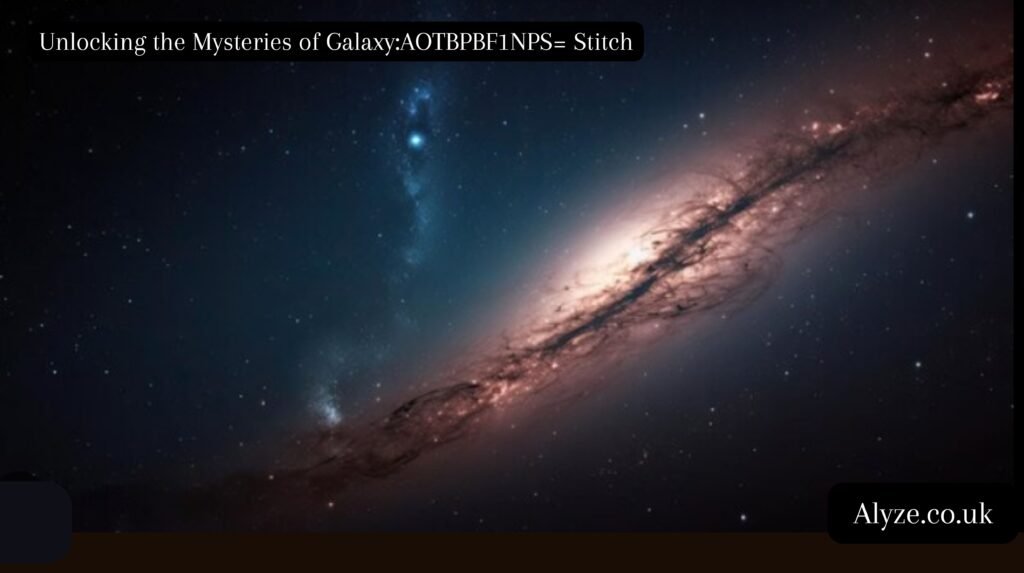Introduction
Galaxy:AOTBPBF1NPS= Stitch : Galaxies hold secrets and wonders that continue to awe both astronomers and space lover worldwide. One such breathtaking celestial body is Galaxy:AOTBPBF1NPS= Stitch. This paper tries to explore the mysterious galaxy’s origin, distinctive features, and some of the scientific values associated with it. To this end, it attempts at rendering a sweeping overview that is both informative and interesting in nature.
Also Read : https://me-encantas.com/2020/03/23/tips-para-rejuvenecer : Tips and tricks to Rejuvenate Oneself
Galaxy:AOTBPBF1NPS= Stitch
With an estimated two trillion galaxies in the universe, each represents certain mysteries and phenomena. Galaxy:AOTBPBF1NPS= Stitch is one of its kind with its designation, alone, and what that has stirred up in the scientific world. Naming the galaxy after some sort of catalog reference in some kind of specialized survey, it presents a unique case study in galactic formation and behavior.
Discovery of Galaxy:AOTBPBF1NPS= Stitch
Galaxy: AOTBPBF1NPS= The first traces of Galaxy:AOTBPBF1NPS= Stitch were found back in the 2010s, in what would prove to be one of the largest surveys ever, conducted with a team of various astronomers around the world. Next-generation telescopes and spectrographic tools were employed, which were aimed at mapping and classifying not-so-prominent galaxies. The particular galaxy, named Galaxy: AOTBPBF1NPS= Stitch, displayed rather peculiar properties that set it’s image aside, and thus, scientists had to take special notice of it in the analysis of the survey results.
The Meaning of Its Name
The name “AOTBPBF1NPS= Stitch” may sound mysterious, but its origin is found within the naming conventions of this survey. “AOTBPBF” stands for Astronomical Optical Telescope Big Planetary Body Finder, while “1NPS” refers to the order and “Stitch” refers to the thread-like continuous distinct structural patterns seen in high-resolution imaging.
Understanding Complexity of Structure
One of the most amazing facts about Galaxy:AOTBPBF1NPS= Stitch is its structure. If we compare it to regular spiral or elliptical galaxies, the galaxy is structured with stitches that resemble weaves one might find in a finely crafted fabric.
Spiral Arms and Central Bulge
The central bulge of it is full of a dense region with older, red-colored stars. Several spiral arms wind and curve around – unlike any other known galaxy – tightly embracing this bulge. Those arms are populated by young, blue stars and areas of active starbirth.
The Stitch Patterns
The “stitch” pattern from which this galaxy gets its unique moniker comprises a set of intricate filaments and loops joining sections of the spiral arms. These are features that should be created through gravitational interaction; thus, dark matter gives a web-like appearance puzzling scientists.
The Role of Dark Matter and Forces of Gravity
That’s where galaxy formation and evolution occur: within dark matter. It is not an exception. The existence of dark matter can be deduced only by looking at the galaxy’s rotational curves and by the behavior of its spiral arms.
Dark Matter
Dark matter is supposed to create the unusual stitch patterns observed through its gravitational pull. In fact, dark matter does create a gravitational lens in its interaction with luminous matter; it bends light and affects the distribution of the stars and gas of the galaxy.
Gravitational Waves and Their Impact
Gravitational waves might be one of the missing keys in the formation process of galaxies like this, which some recent studies specify. Gravitational waves are little ripples in space-time produced by huge cosmic events and thus might shape the movement of stars and gasses that form the complicated structure of a galaxy.
Star Formation and Evolution
The details in the structure of it offer a very fertile ground for star formation. Gas, dust, and gravity drive the emergence of zones of intense stellar activity.
Star-formation regions
It is in these spiral arms that numerous regions have been found with new star formation. These star-forming regions are illuminated by the intense radiation of young, huge stars and are rich in molecular hydrogen and other needed elements.
The Life Cycle of Stars
Stars within it follow an entire lifecycle, from birth in stellar nurseries to eventual death as white dwarfs, neutron stars, or black holes. The varied stellar population gives insight into the processes by which stellar evolution is governed.
Cosmic Phenomena and Anomalies
Galaxy:AOTBPBF1NPS= Stitch does not stand as a passive viewer in the universe; it is rather an active entity hosting a number of cosmic phenomena.
Supernovae Explosions
It has hosted several observed supernovae, which are explosions that mark the end in a star’s life cycle. Events of this kind are not only breathtaking but also very important in the dispersion of heavy elements throughout the galaxy.
Black Holes and Neutron Stars
The central bulge of it is likely contains a supermassive black hole, a common feature in many galaxies. The remnants of massive stars, such as neutron stars, are also scattered everywhere in the galaxy, enriching it in various astrophysical features.
FAQs about Galaxy:AOTBPBF1NPS= Stitch
Q: What is special about it?
A: Its structure, resembling a big stitch, and action like dark matter with gravitational waves make this galaxy special compared to others.
Q: How was it discovered?
A: It was identified during an international astronomical survey, which combed through the universe using next-generation telescopic and spectroscopic technologies.
Q: What role does the dark matter play in this galaxy?
A: It’s influencing the structure of the galaxy to create these almost stitch-like patterns due to gravitational interactions.
Conclusion
It only goes on to prove how much detail and beauty exist out there in the universe. One structure, carved by dark matter and gravitational forces, speaks volumes about dynamic processes that drive galaxy evolution. The more astronomers observe this astonishing galaxy, the more it promises to give up secrets about the universe. It is through research and exploration that it will capture your imagination and further our understanding of the universe. See More…



